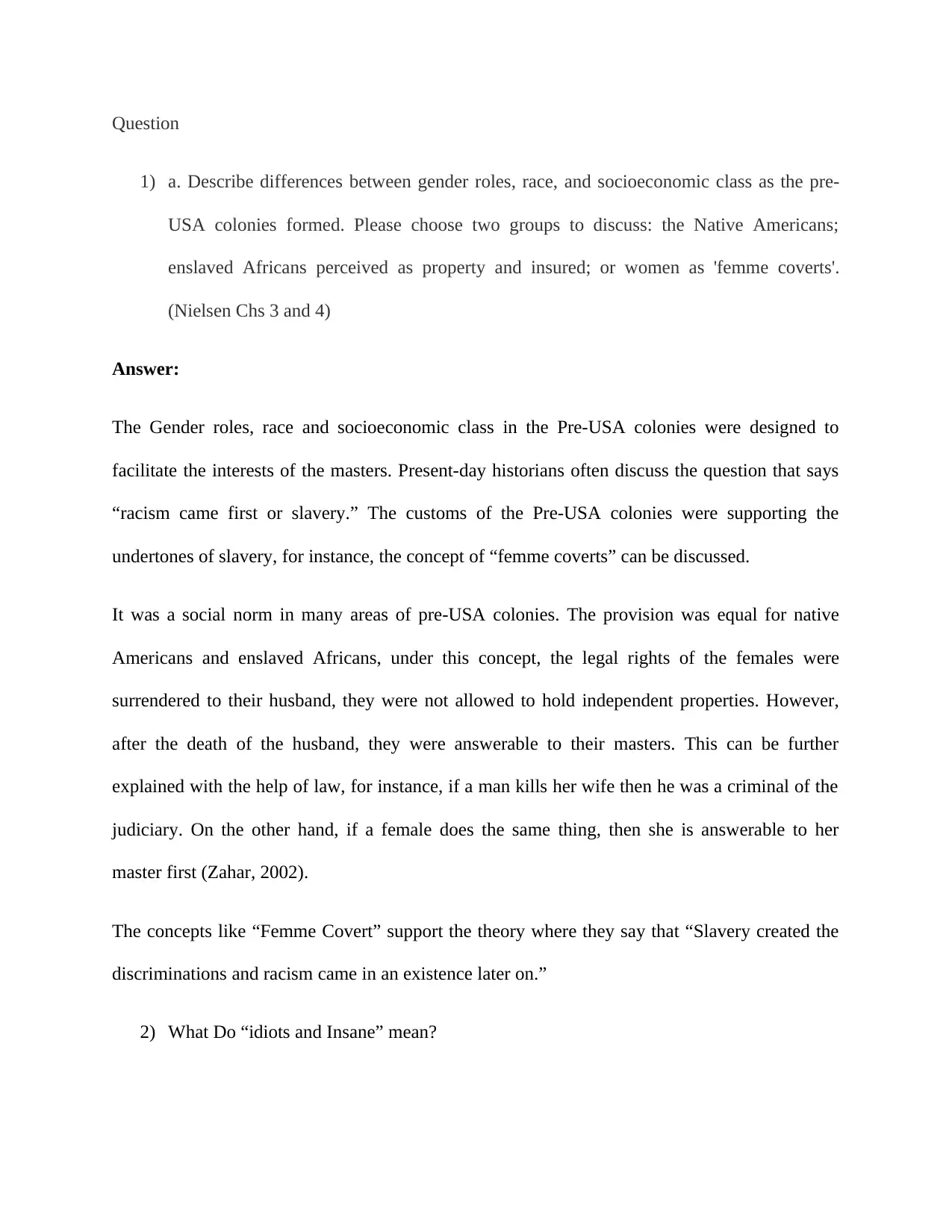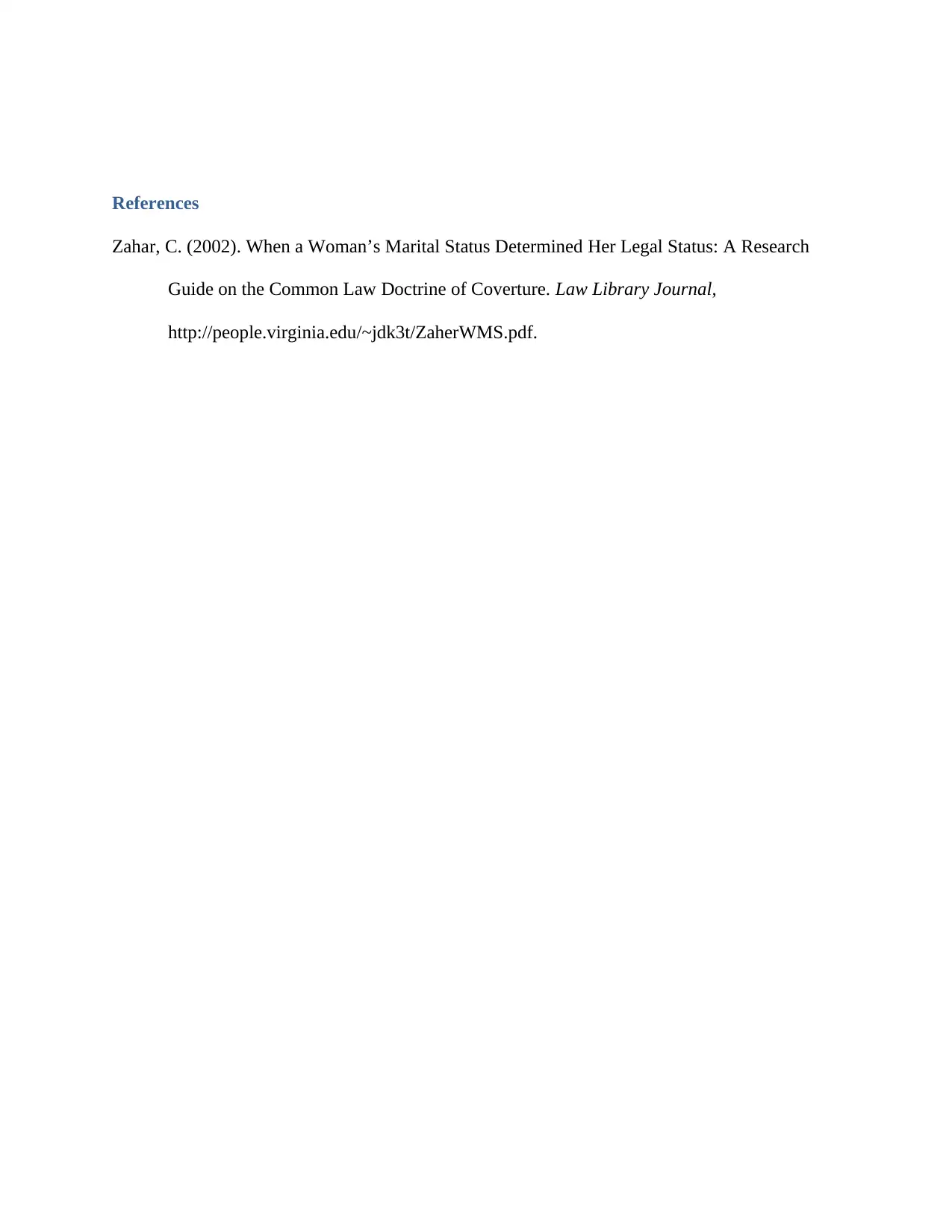Socioeconomic class as the pre-USA Colonies formed - Question
VerifiedAdded on 2022/08/18
|3
|381
|30
AI Summary
Contribute Materials
Your contribution can guide someone’s learning journey. Share your
documents today.

Question
1) a. Describe differences between gender roles, race, and socioeconomic class as the pre-
USA colonies formed. Please choose two groups to discuss: the Native Americans;
enslaved Africans perceived as property and insured; or women as 'femme coverts'.
(Nielsen Chs 3 and 4)
Answer:
The Gender roles, race and socioeconomic class in the Pre-USA colonies were designed to
facilitate the interests of the masters. Present-day historians often discuss the question that says
“racism came first or slavery.” The customs of the Pre-USA colonies were supporting the
undertones of slavery, for instance, the concept of “femme coverts” can be discussed.
It was a social norm in many areas of pre-USA colonies. The provision was equal for native
Americans and enslaved Africans, under this concept, the legal rights of the females were
surrendered to their husband, they were not allowed to hold independent properties. However,
after the death of the husband, they were answerable to their masters. This can be further
explained with the help of law, for instance, if a man kills her wife then he was a criminal of the
judiciary. On the other hand, if a female does the same thing, then she is answerable to her
master first (Zahar, 2002).
The concepts like “Femme Covert” support the theory where they say that “Slavery created the
discriminations and racism came in an existence later on.”
2) What Do “idiots and Insane” mean?
1) a. Describe differences between gender roles, race, and socioeconomic class as the pre-
USA colonies formed. Please choose two groups to discuss: the Native Americans;
enslaved Africans perceived as property and insured; or women as 'femme coverts'.
(Nielsen Chs 3 and 4)
Answer:
The Gender roles, race and socioeconomic class in the Pre-USA colonies were designed to
facilitate the interests of the masters. Present-day historians often discuss the question that says
“racism came first or slavery.” The customs of the Pre-USA colonies were supporting the
undertones of slavery, for instance, the concept of “femme coverts” can be discussed.
It was a social norm in many areas of pre-USA colonies. The provision was equal for native
Americans and enslaved Africans, under this concept, the legal rights of the females were
surrendered to their husband, they were not allowed to hold independent properties. However,
after the death of the husband, they were answerable to their masters. This can be further
explained with the help of law, for instance, if a man kills her wife then he was a criminal of the
judiciary. On the other hand, if a female does the same thing, then she is answerable to her
master first (Zahar, 2002).
The concepts like “Femme Covert” support the theory where they say that “Slavery created the
discriminations and racism came in an existence later on.”
2) What Do “idiots and Insane” mean?
Secure Best Marks with AI Grader
Need help grading? Try our AI Grader for instant feedback on your assignments.

The concept of the “Idiots and Insane” refers to a clan of individuals who were not allowed to
hold properties or enjoy civil rights because of their physical disabilities or mental status. The
connotation of this phrase continued in the post colonized era as well when Voting rights for
these individuals were prevented because of their disabilities.
hold properties or enjoy civil rights because of their physical disabilities or mental status. The
connotation of this phrase continued in the post colonized era as well when Voting rights for
these individuals were prevented because of their disabilities.

References
Zahar, C. (2002). When a Woman’s Marital Status Determined Her Legal Status: A Research
Guide on the Common Law Doctrine of Coverture. Law Library Journal,
http://people.virginia.edu/~jdk3t/ZaherWMS.pdf.
Zahar, C. (2002). When a Woman’s Marital Status Determined Her Legal Status: A Research
Guide on the Common Law Doctrine of Coverture. Law Library Journal,
http://people.virginia.edu/~jdk3t/ZaherWMS.pdf.
1 out of 3
![[object Object]](/_next/static/media/star-bottom.7253800d.svg)
